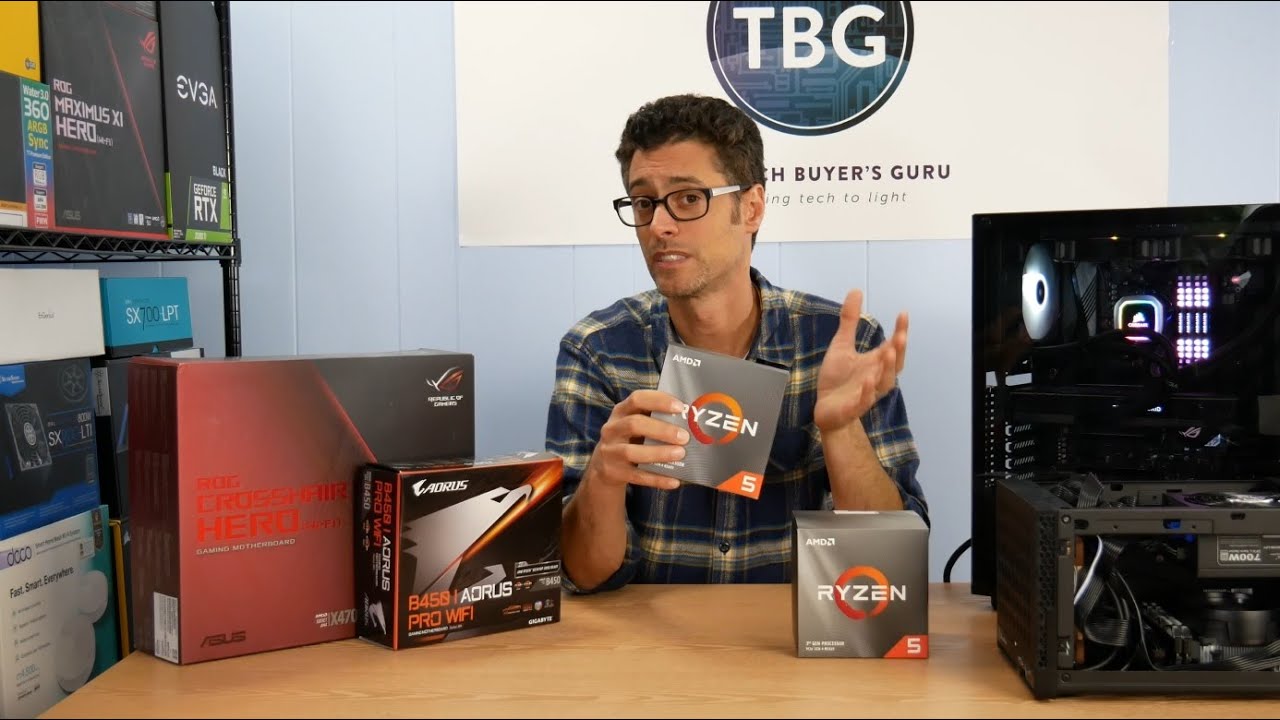AMD’s Ryzen 5 3600 and 3600X: Unprecedented Performance
Pros
Cons
Rating
Introduction
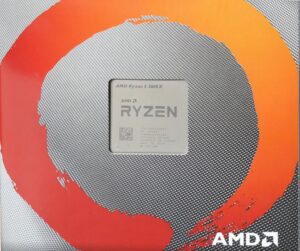
We’ve been reviewing Ryzen CPUs and APUs ever since the release of the 1000-series in 2017, and have typically come away very impressed. You can see our take on the Ryzen 7 1700, the Ryzen 7 2700X and Ryzen 5 2600X, the Athlon 200 series, and most recently the Ryzen 3 3400G and Ryzen 5 3400G. But what we’ve been most excited was the promise of Zen 2, which AMD has been talking up since day one. Well, it’s finally here, and this review of the least expensive members of the Zen 2 family, the Ryzen 5 3600 series, will show that it was worth waiting for!
Special thanks to AMD for providing samples of the Ryzen 5 3600 and Ryzen 5 3600X for review.
Test Setup
We tested the Ryzen 5 3600 and Ryzen 5 3600X in two different test systems, which had the following specs:
- Motherboard: Asus ROG X470 Crosshair VII Hero (Wi-Fi)
- RAM: Corsair 4x8GB Dominator Platinum RGB DDR4-3600
- SSD: Samsung 960 Evo 500GB
- Case: SilverStone PS14-E ATX
- Cooler: AMD Wraith Stealth, Wraith Spire, and Corsair Hydro H100i RGB Platinum
- Operating System: Windows 10
- Motherboard: Gigabyte B450 I Gaming
- RAM: G.Skill 2x8GB Sniper X DDR4-3400
- SSD: Samsung 860 Evo 500GB
- Case: SilverStone SG13 Mini-ITX
- Cooler: AMD Wraith Stealth and Wraith Spire
- Operating System: Windows 10
All of our gaming tests were conducted with the EVGA GeForce GTX 1080 8GB video card. We did request that AMD send us a sample of the similarly-fast Radeon RX 5700 8GB, but they unfortunately didn’t come through. We’re hoping that AMD’s CPU and GPU team work more closely together in the future in marketing these products, because now that AMD is competitive in both the CPU and GPU markets, they should capitalize on being the only company that can equip an entire PC for gaming purposes!
You’ll note that we actually swapped through several coolers during our tests to see how the Wraith Stealth included with the 3600 and the Wraith Spire included with the 3600X compared, and whether liquid cooling could unlock additional performance. We also made an unanticipated jump up to 32GB of DDR4-3600 in our ATX system, which previously had failed to boot when paired with a Ryzen 7 2700X. This is proof positive that the Zen 2 memory controller built into the 3600 series is indeed far superior to what was included in Zen+ CPUs, like the Ryzen 7 2700X we’ve included in our benchmark results. That CPU couldn’t boot the impressive Corsair Dominator Platinum kit at anything higher than DDR4-2933, so that was how we ran it in the benchmarks. Clearly, Zen 2 is far superior in that regard, and gets credit for that in the benchmark results! We stuck with DDR4-3400 in our ITX system, simply because that’s the kit AMD previously supplied to us for Ryzen testing.
For comparison purposes, we included five other CPUs in our benchmarks. On the Intel side, we have the quad-core Core i7-6700K, the eight-core Core i9-9900K, both of which use the original Skylake architecture that debuted in 2016. As you’ll see, little distinguishes these CPUs other than the core count and higher clock speed of the 9900K. On the AMD side, we have three Zen+ CPUs, the Ryzen 3 3200G, the Ryzen 5 3400G, and the Ryzen 7 2700X. Note that the 3200G is in the mix to show what happens when a CPU doesn’t include virtual cores (Intel’s Hyperthreading or AMD’s Simultaneous Multi-Threading). Intel has been very stingy with its HT technology in its current CPU lineup, while AMD bestows every 3000-series CPU other than the 3200G with it. As you’ll see, it’s a big benefit to performance across the board.
We put together a video review of the Ryzen 5 3600 and 3600X, which summarizes our findings – check it out below!
Want more detail? Then read on!
The Benchmark Utilities
On this page, we provide benchmark results from four well-known utilities, Geekbench 4 representing office PC usage, 3DMark Fire Strike Physics representing computational applications, and Cinebench and V-Ray representing content creation.
Geekbench 4
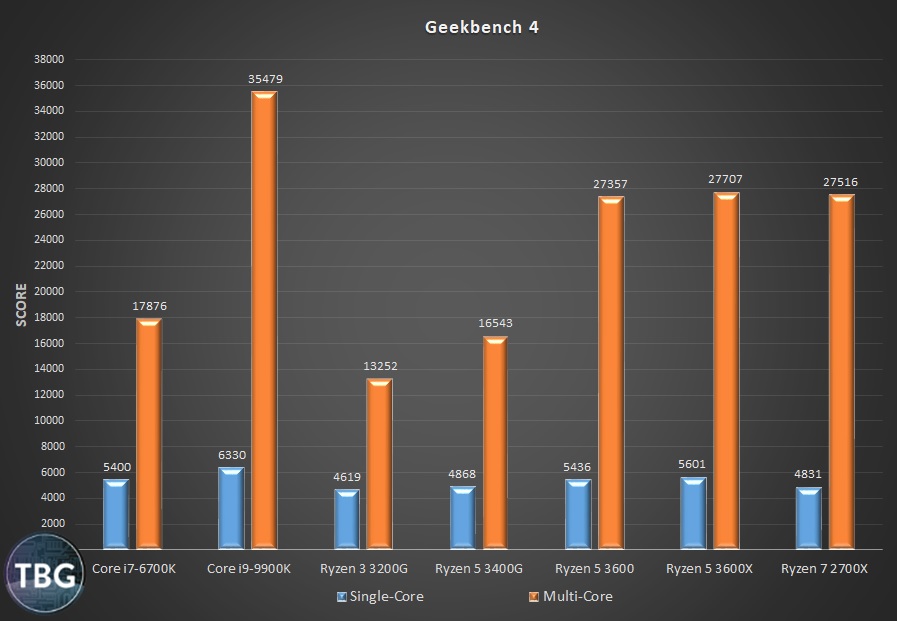
Right out of the gate, we see the Ryzen 5 3600 series prove that Intel has much to fear in Zen 2. These chips beat the Core i7-6700K both in single-core and multi-core metrics, despite a nearly identical clockspeed (about 4.2GHz on a single core and 4GHz with a multi-core load). Yes, the Core i9-9900K is still way ahead in terms of the single-core number, but that’s because it boosts to 5GHz, a clock speed AMD still can’t touch. But Intel doesn’t offer that kind of boost speed plus its effective Hyperthreading technology in any 9000-series CPUs other than the $500 9900K, to our ongoing astonishment! Note how effective AMD’s SMT technology is in the 3400G vs. 3200G comparison. Despite nearly identical single-core performance, the 3400G is 25% faster in the multi-core benchmark. Intel is handing AMD a victory over and over by pitting its HT-less Core CPUs against AMD’s offerings at each respective pricepoint.
As an aside, Intel’s Skylake architecture was certainly groundbreaking in 2016, but it’s remained stuck in time since then. The 9900K’s single-core performance is just 17% higher than the 6700K, and that comes down entirely to its 19% higher Turbo speed (5GHz vs. 4.2GHz). Rest assured that no matter how Intel markets its latest CPUs, they are based on very old tech.
3DMark Fire Strike Physics
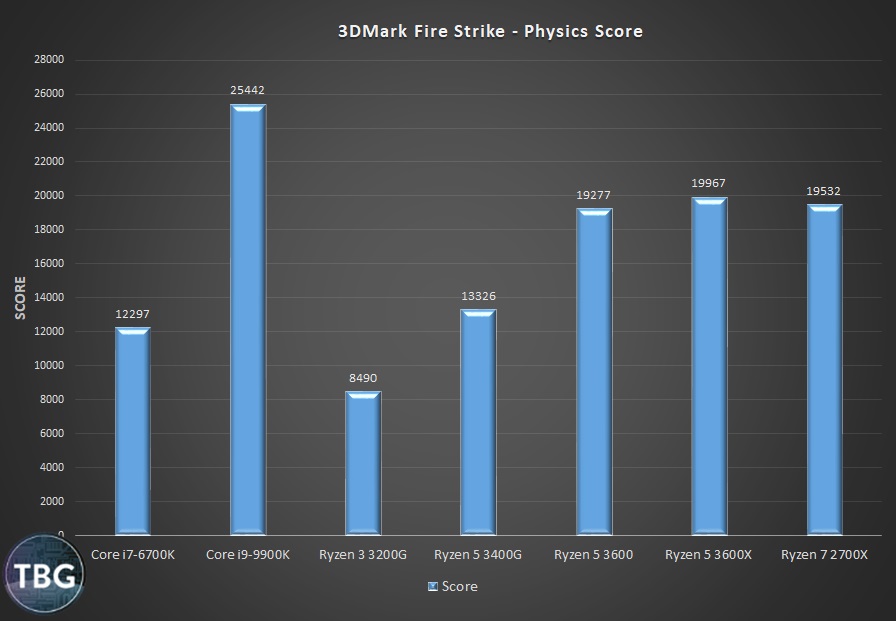
Wow, take a look at how the 3600 series is able to go toe-to-toe with the 8-core Ryzen 7 2700X in this test. Impressive! The 3600 twins are also able to more than split the difference between the 6700K and 9900K, coming in at around 58% faster and 30% slower, respectively. That’s just fine given their core count.
Cinebench

Cinebench is a well-known and heavily-utilized benchmarking utility that happens to be fairly AMD-friendly. It was one of the benchmarks first “leaked” by AMD when it launched the Ryzen line in 2017. Cinebench indeed made Ryzen processors, which were brimming with cores and threads, look very good versus the Intel competition. And with each iteration of Zen, AMD pulls further ahead. The Ryzen 5 3600 is 78% faster than the Core i7-6700K, despite a slightly-lower clock speed and just 50% more cores. Simply put, its architecture is better than Intel’s. Note, however, that the Ryzen 5 3600X doesn’t beat the 3600 here, a theme we will return to several times in this review.
V-Ray
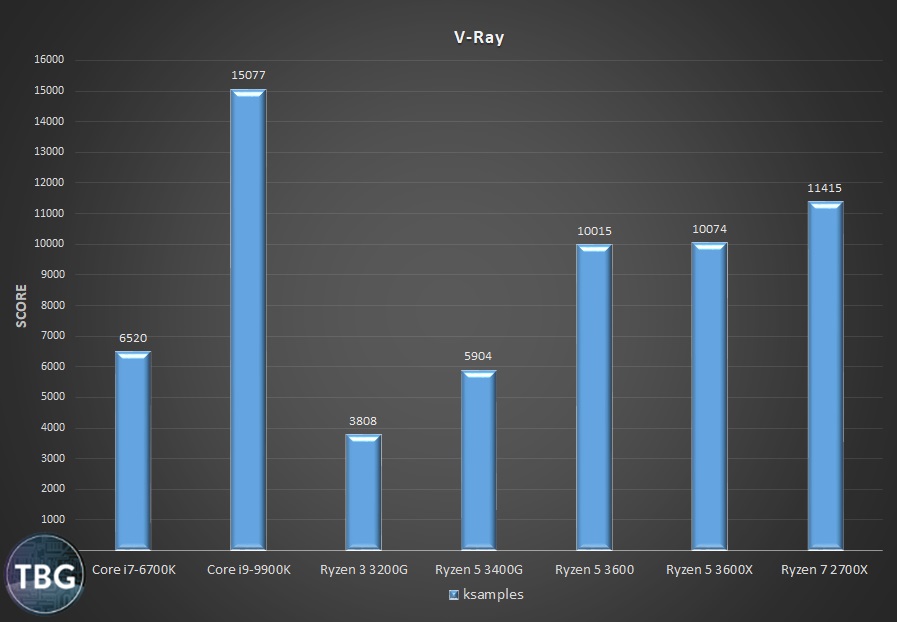
The results here end up quite similar to Cinebench, not surprising given that they test similar capabilities, but it’s important to note that they do so in different ways. V Ray demonstrates the maximum amount of work that a CPU can do in 1 minute, while Cinebench tests how long long it takes a CPU to perform a discrete task. The good news for AMD is that its 3600 CPUs are still more than 50% faster than the Core i7-6700K, proving again that Zen 2 delivers a massive uplift in performance. Note that the similarly-clocked quad-core Ryzen 5 3400G, which is based on the Zen+ architecture, falls far behind the quad-core 6700K. Zen+ simply didn’t equal the Skylake architecture on a clock-for-clock basis.
Gaming Benchmarks
The next six benchmarks use commercial game titles, which we ran at 2560 x 1440, as this is the optimal setting for our GTX 1080 video card, which while a previous generation card, represents the performance you’ll get from a $350-$400 card today, i.e., one that you’d likely want to pair with a $200-$250 CPU. We take issue with reviewers that run their benchmarks on high-end video cards at 720p or 1080p, because it doesn’t represent how a balanced PC will run a game. If you want to test an upper-midrange system, you should test it at settings that users will want to use. Could we have tossed our RTX 2080 Ti into these system and run all the benchmarks at 1080p? Sure we could, and you’d see completely CPU-limited numbers that didn’t translate at all to reality. As you’ll see, some of our benchmarks are CPU-limited, some are GPU-limited, but all will reveal important aspects of the performance of our CPUs.
So, with that as background, on to our benchmarks!
Rise of the Tomb Raider
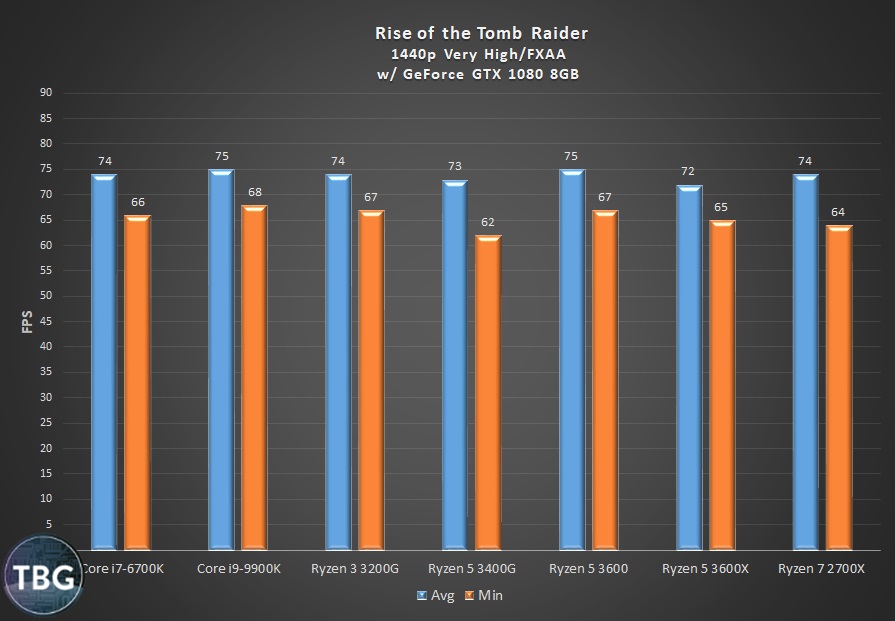
We’re using the second installment in the impressive reboot of the Tomb Raider series to show you how a game performs when it’s primarily GPU limited. The Tomb Raider games have never demanded much from CPUs, and in this case, we we see all of the CPUs performing at around the same level. Our hunch is that this game engine cannot utilize more than four cores.
DOOM
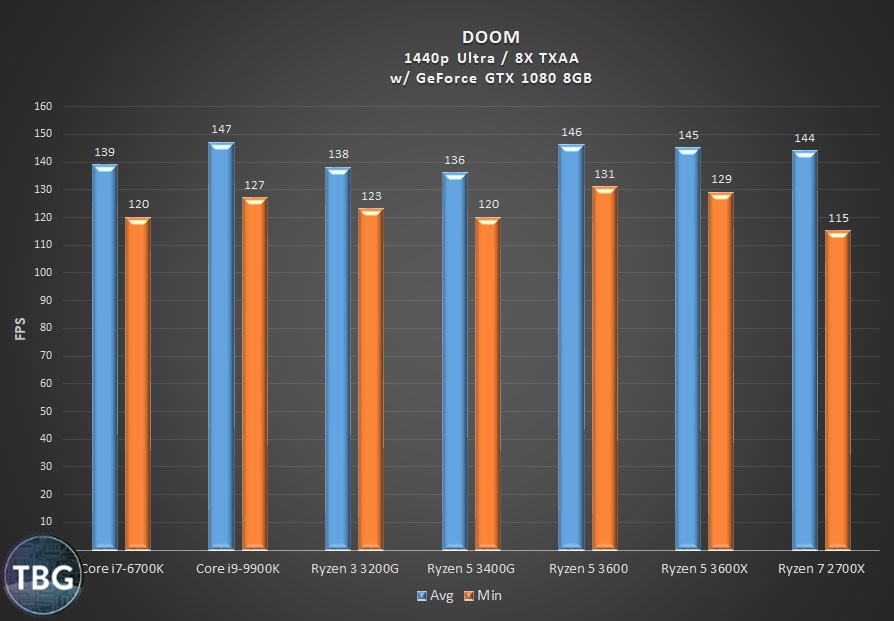
The results in DOOM are similar at first glance to Tomb Raider, but look more closely and you’ll see definite patterns. The Zen+ CPUs and APUs really struggle with regard to minimums, despite putting up fairly-competitive averages. In particular, the Ryzen 7 2700X falls far behind the newer 3600 twins, which actually pull ahead of even the 9900K in terms of minimums, while essentially matching its average.
Rocket League
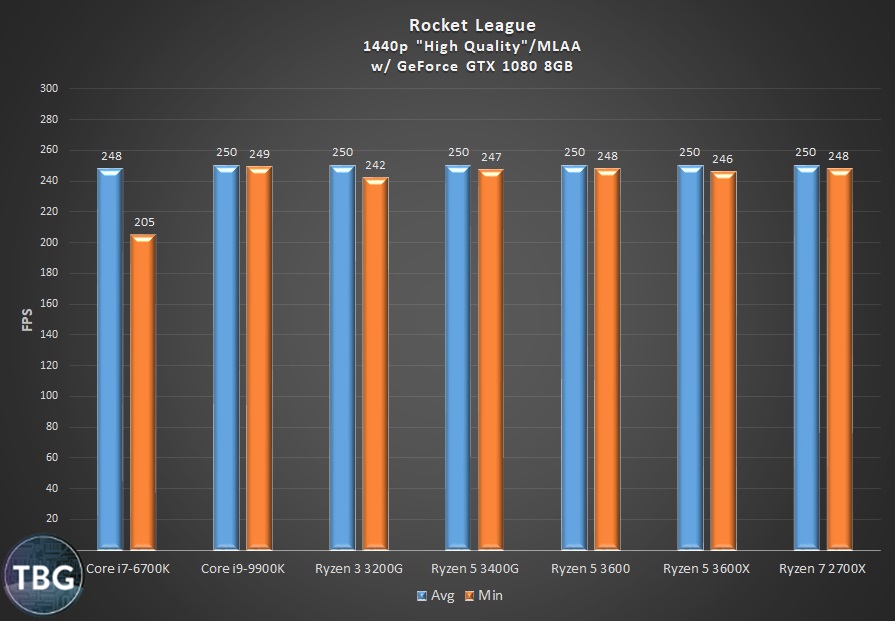
OK, so if you didn’t like the GPU-limited games above, how about a framerate-limited game like Rocket League?!? This represents a typical low-intensity eSports title, and it shows that for the most part, you don’t need a ton of CPU power to max out these games.
Dirt Rally
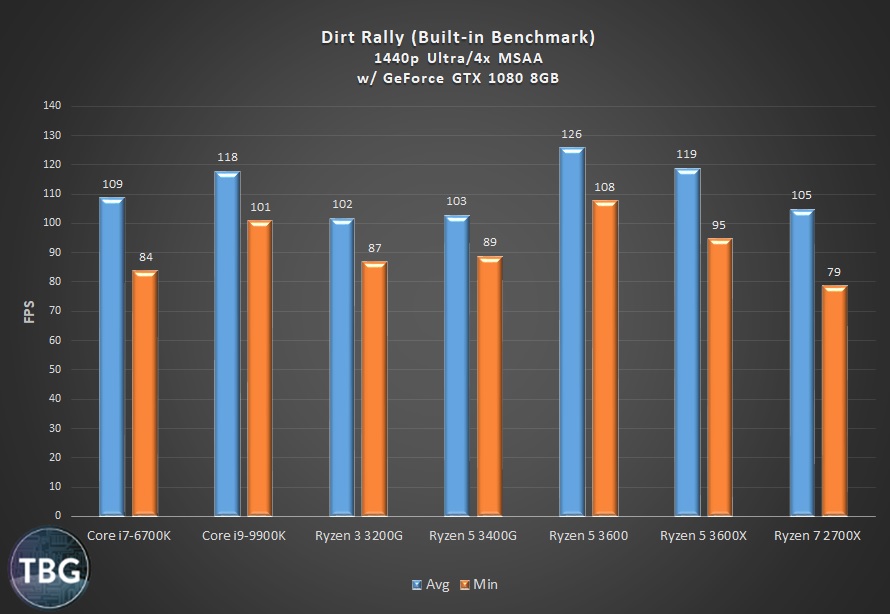
All right, all right, we’ll get into some CPU games already! As with many driving simulators, Dirt Rally is highly dependent on CPUs for physics calculations, and the 3600 series gets a huge win here, even besting the 9900K. Note, however, that the 3600 beats the “faster” 3600X, which calls into question how different these CPUs really are! Also note that the Zen+ architecture just couldn’t stretch its legs in this game – the 2700X is only on par with the 3200G and 3400G, despite four times and two times the number of threads, respectively. This is why we never recommended Zen+ CPUs in anything other than budget-oriented gaming machines. They just didn’t have a design that catered to gaming.
Battlefield 4
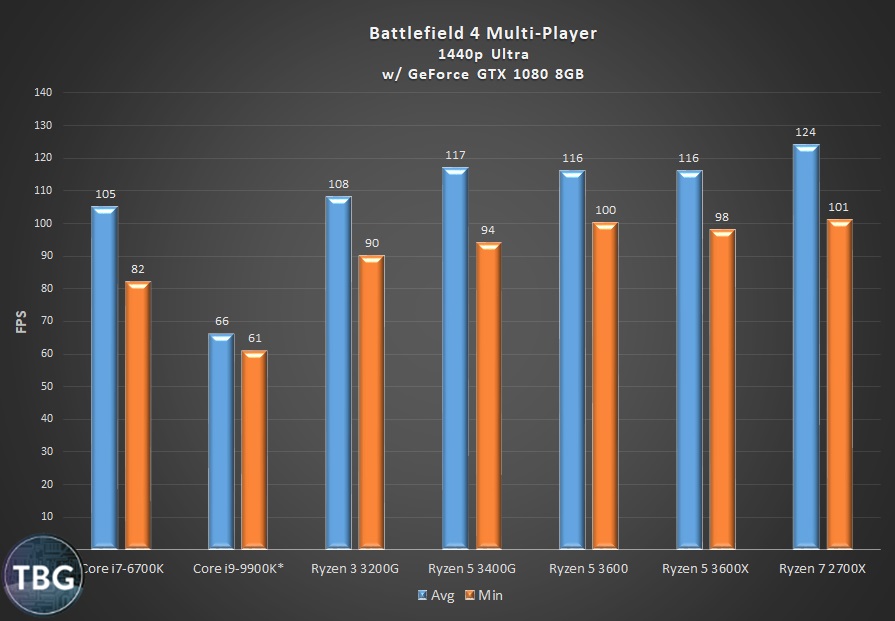
Now into one of our favorite games ever, Battlefield 4. Having been released in 2013, it’s by far the oldest game in our benchmark suite, but that means its multi-player mode is a particularly good test of CPU power. You see, multi-player matches are notoriously hard on CPUs, and in the past we’ve found that Intel’s CPUs crater in this benchmark when they aren’t boosted by Intel’s Hyperthreading. With that said, even with Hyperthreading, Intel is a mess in this benchmark. The 6700K is being bested by a $100 APU, while the 9900K performed terribly in this benchmark, as it has since the day we installed it. We even tossed our RTX 2080 Ti into the system to make sure something hadn’t gone wrong with our GTX 1080, and alas, it still under-performed the AMD CPUs. Our guess is that the older Frostbite game engine has some sort of incompatibility with Intel CPUs at such high core counts.
Interestingly, the fastest CPU in this test was the Ryzen 7 2700X, which suggests that this old title doesn’t have problems with eight-cores generally – just Intel’s!
Battlefield V
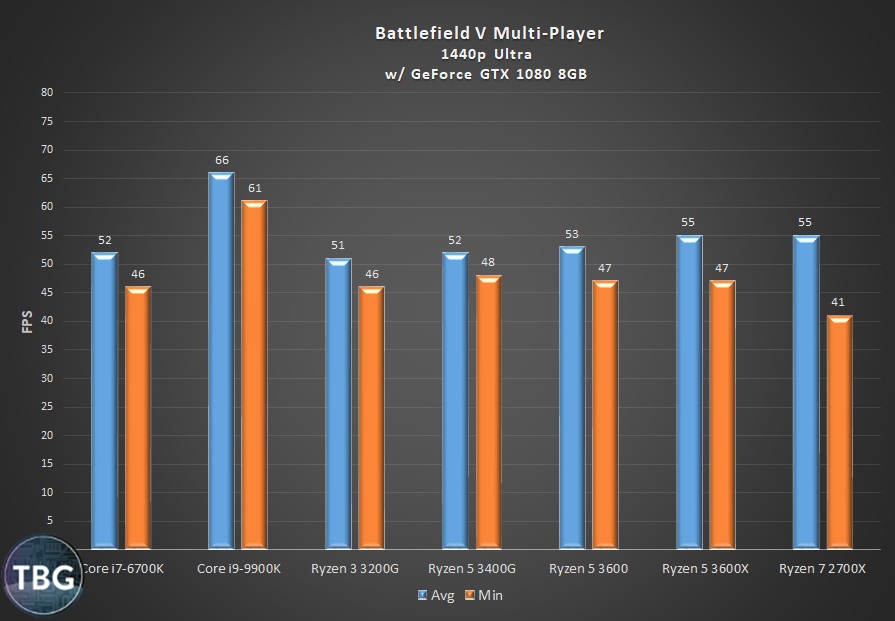
OK, here’s another take on the multi-player benchmark, Battlefield V, released in 2018. You can see that this game is much more GPU-limited (halving the framerates at the same resolution and quality level), which means CPUs are less important. The only CPU to distinguish itself here is the 9900K, which is still the undisputed gaming champ for modern titles. With that said, we did have one issue with the benchmark run on the 9900K: we simply could not find a full server to run the Devastation map on after running that map on all our other CPUs. Indeed, we were shocked at how desolate the game lobby was for this game, and we are afraid it’s a sign that the Battlefield series has run its course. To our chagrin, we’re nearly certain EA/DICE will not release any new Battlefield titles in the future.
Overclocking
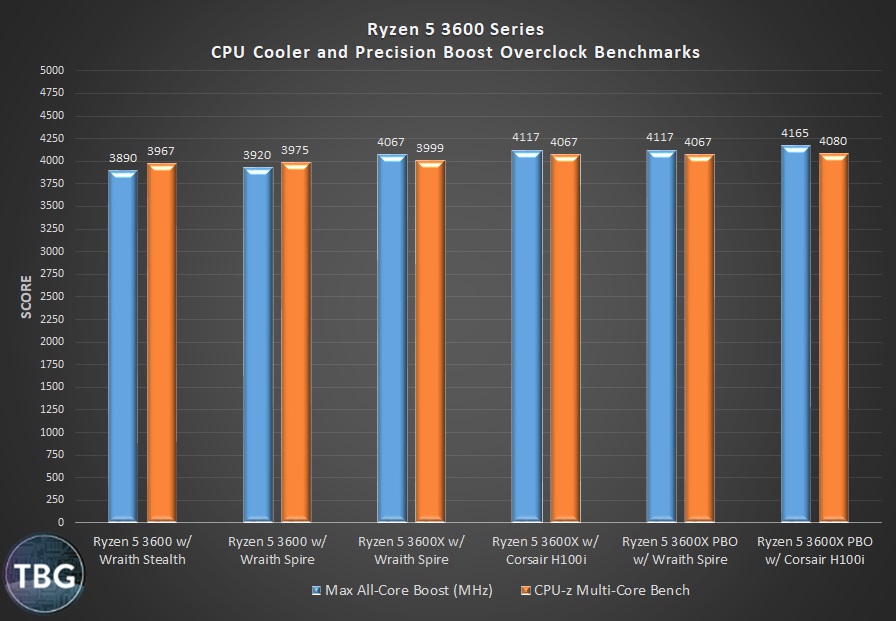
We decided to focus in on two factors when it comes to clockrates: AMD’s Precision Boost, which automatically (automagically?) adjusts clockrates based on the cooler used, and then Precision Boost Overdrive, which is an auto-overclocking routine available in the Ryzen Master software suite.
As you can see if you study the data above carefully, the simple act of swapping out a cooler actually boosts clock speeds on both the 3600 and 3600X. For example, using the Spire cooler included with the 3600X on the cheaper 3600 actually boosted speed by 30MHz. Similarly, moving from the Spire to a liquid cooler on the 3600X boosted speed by 50MHz. This was without making any changes to CPU settings. So if you want a risk-free performance upgrade (albeit a small one), just get a better cooler. Combine a better cooler with PBO and you get even more performance: the 3600X picked up another 50MHz when using PBO with a liquid cooler, for a 100MHz overall boost over stock. One issue we had with the 3600X’s Spire cooler was that it was absurdly loud in this test. It ran at 44dB and 3200RPM, compared to 36dB and 2600RPM for the smaller Wraith Stealth. That is a tradeoff not worth making given how little extra performance it unleashes in the 3600 (and the 3600X, for that matter).
Alas, for better or for worse, AMD is getting the most out of its Zen 2 architecture, leaving little on the table in terms of overclocking. Our manual overclocking tests only boosted speed of our 3600X to 4.2GHz, and that was with more voltage than we would have liked (1.45V). We think the very best approach to maximizing the performance of Zen 2 is to get the lowest-tier CPU in the lineup, here the Ryzen 5 3600, and then upgrading it with a nice, quiet tower cooler like the Arctic Freezer 34 eSports Edition.
Power Draw
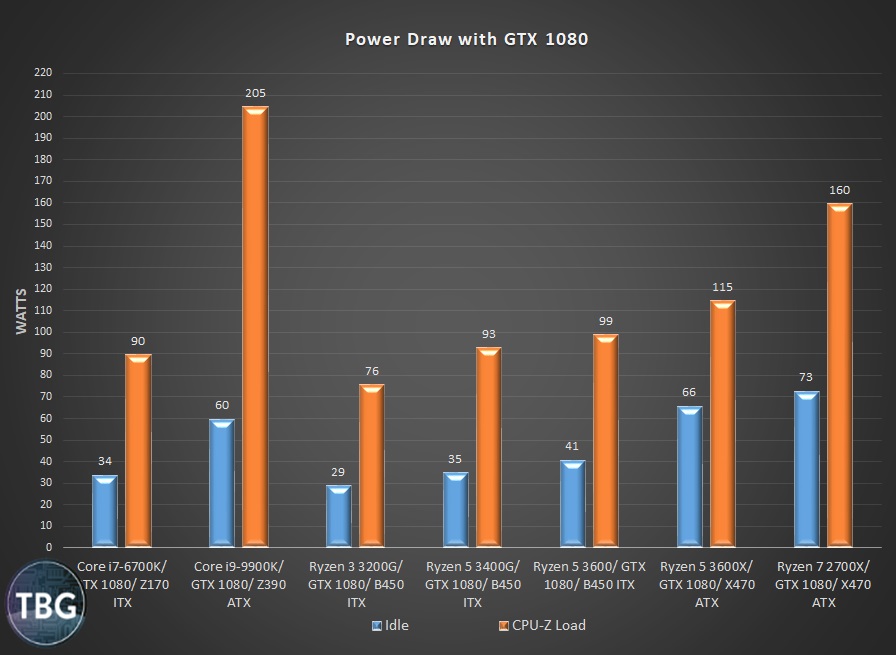
OK, first things first, we tested our CPUs on several different motherboards, and you have to take into account their power draw in the chart above. So don’t compare the 3600X to the 3600, but rather to the 2700X, which used the same motherboard. Note how much more efficient Zen 2 is, given that in many tests the 3600X was far faster. Likewise, feel free to compare the Ryzen 5 3600 to the Zen+-based Ryzen 5 3400G or the Skylake-based Core i7-6700K. Despite using slightly more power overall, it offers far more performance per Watt than either of those CPUs (up to 50% more in CPU-intensive tasks).
We are a bit concerned, by the way, that the 65W-rated Ryzen 5 3600 uses nearly 100W in this test, which we have a hard time believing was due entirely to its motherboard. We think this is a sign that the 65W 3600 and 95W 3600X are actually both more like 90W processors that differ almost entirely in single-core boost speed, while performing the same, and drawing similar power, in multi-core tests like this one. Artificial product stack differentiation for the loss.
On a related and more flagrant note Intel’s TDP ratings are now the laughing-stock of the industry, as its “95W” Core i9-9900K uses over 200W in this test. Seriously, this is becoming a joke, and we’re starting to wonder if it borders on false marketing.
Conclusions
Wow, just wow! Zen 2 delivers! While we’ve been impressed with AMD’s Ryzen lineup in the past, it’s the Zen 2 architecture used in the new Ryzen 3000 series of CPUs that really delivers the knock-out punch we’ve all been waiting for. The Ryzen 5 3600 and Ryzen 5 3600X have finally caught up to Intel’s aging Skylake architecture, which is still used today in all of its CPUs, in term of instructions per clock cycle, while offering far more cores and virtual cores per dollar. Consider that the Ryzen 5 3600 is the same price class as the Intel Core i5-9400, yet runs at higher boost speeds and offers SMT, allowing it to deliver up to 50% higher performance per dollar. It continues to shock us that Intel hasn’t responded to AMD’s Ryzen assault by offering Hyperthreading on its mid-priced CPUs, but that’s left the door wide open for AMD, which has responded with gusto. There is simply no reason to buy any other CPU between the $150 and $250 pricepoints.
But not everything is perfect in this product launch. First off, we think the Ryzen 5 3600X is simply a non-starter in terms of value, serving only the goal of market segmentation. AMD needed a CPU at the competitive $250 pricepoint, where the Core i5-9600K typically resides, but the 3600X and its loud Wraith Spire cooler simply don’t deliver the goods. Just stick to the 3600 and you’ll be better off. We think AMD should give up on artificially segmenting its product line, and just simplify its offerings with the one best product at the best price in the 6- and 8-core markets. It should have learned this lesson long ago when its Ryzen 7 1700 became the darling of the Ryzen 1000 series thanks to its ability to match the 50% more expensive Ryzen 7 1800X. Alas, we don’t think AMD’s going to do this anytime soon, because those higher-priced SKUs are all about margins, given they cost barely any more to produce than what may be loss leaders in each product family. So anyone who wants to subsidize enthusiasts on a budget can go out and buy the 3600X and feel good about it!
The other concern we have about these CPUs has nothing to do with their performance, but rather their ecosystem. While AMD is delivering tremendous value to consumers by maintaining socket compatibility year-to-year, it keeps digging a tremendous hole for itself by not working with motherboard partners to get lower-priced motherboards into the retail channel with proper firmware support. With the least-expensive X570 boards coming in around $170, buyers of the budget-priced Ryzen 3000 series CPUs (including the 3200G and 3400G), are stuck with a Catch-22. Buy an older motherboard at a good price and be nearly guaranteed to have out-of-date firmware, or buy an X570 motherboard and pay a premium just for the firmware. We know that AMD eventually plans to release a B550 chipset, but a product delivered 6 months late is of little good today. Instead, it should allow motherboard manufacturers to get firmware-updated versions of existing motherboard into the channel before new CPUs are even launched, and update the names of these motherboards with clear suffixes to inform consumers exactly what they’re getting, like “Ryzen 3000 Edition”. We know MSI is attempting to go it alone by offering up its MAX line of motherboards with updated firmware, but that’s too little, too late, and honestly, AMD should be leading the way in sorting out this mess of its own making, not a single manufacturer.
With all that said, there’s no denying that Zen 2 delivers, and we give a huge perfect 5-star rating to the Ryzen 5 3600, which is available for $194 as of our publication date. As for the Ryzen 5 3600X, which is $240 from Amazon, we give it a 3.5-star rating, simply because its less expensive cousin is a much better overall package.
As always, to get our recommendations on the best PC builds at every price point, see our Do-It-Yourself PC Buyer’s Guides!


